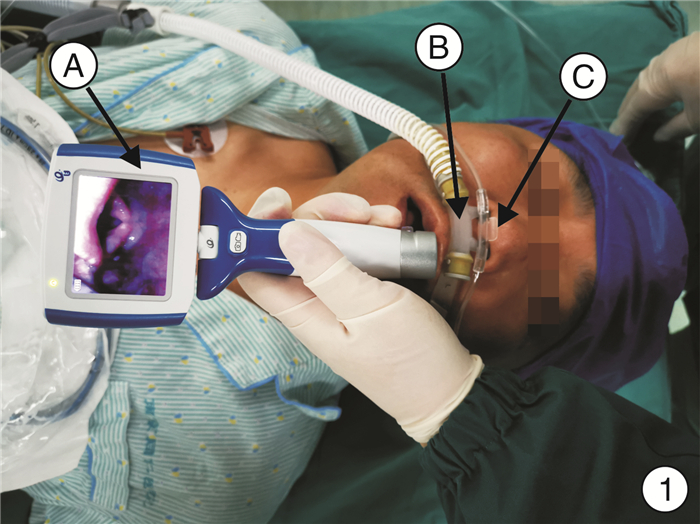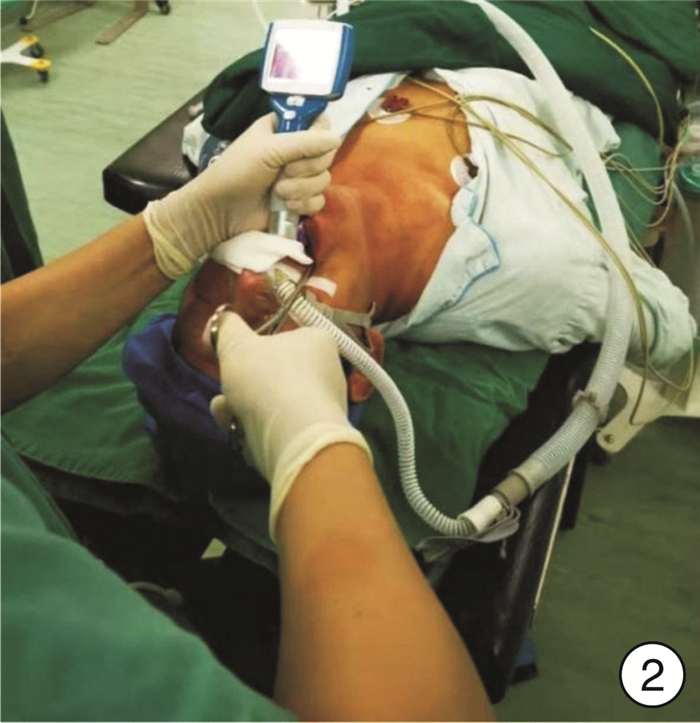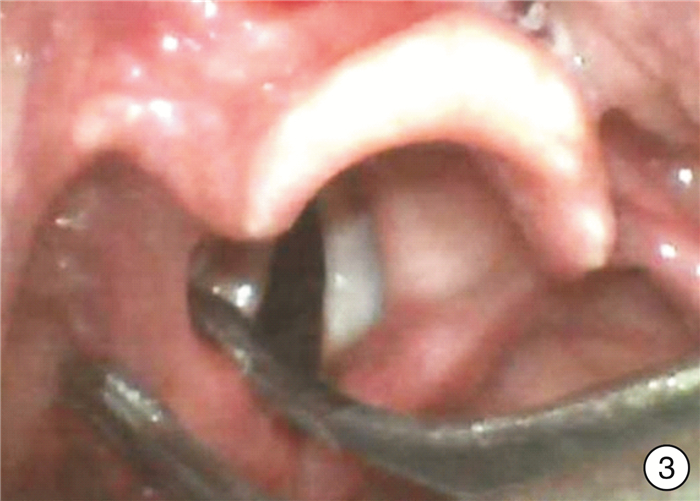-
摘要: 目的 探讨湿化高流量鼻导管氧疗(HHFNC) 配合可视喉镜在环杓关节脱位复位术中的应用价值。方法 将29例环杓关节脱位患者随机双盲分为HHFNC组和普通鼻导管氧疗组,比较两组术中及术后评估指标、麻醉相关指标以及术前术后声带情况。结果 两组术中血氧饱和度、微旁流二氧化碳分压、呼吸频率、呼吸干预次数的差异均有统计学意义(P<0.05),术后心率、血氧饱和度、呼吸频率的差异有统计学意义(P<0.05)。两组患者有效呼吸时长、麻醉苏醒时间及苏醒评分的差异有统计学意义(P<0.05)。复位后患者嗓音障碍指数、嗓音异常程度、粗糙声、气息声、无力样发音及紧张性发音术后较术前变化显著。结论 HHFNC配合可视喉镜下环杓关节脱位复位术,麻醉安全性高,患者配合度好,手术效果良好。
-
关键词:
- 环杓关节脱位 /
- 湿化高流量鼻导管氧疗 /
- 可视喉镜
Abstract: Objective To study the application value of humidified high flow nasal cannula (HHFNC) combined with visual laryngoscopy in the arytenoid cartilage dislocation.Methods Twenty-nine patients with arytenoid cartilage dislocation were randomly double-blind into HHFNC group and general nasal catheter oxygen suction group, and the intraoperative and postoperative evaluation indicators, anesthesia-related indicators and postoperative vocal cord were compared.Results There were statistically significant differences in intraoperative blood oxygen saturation, microstream end-tidal carbon dioxide partial pressure EtCO2, respiratory rate and respiratory intervention times between the two groups (P < 0.05), and statistically significant differences in postoperative heart rate, oxygen saturation and respiratory rate (P < 0.05). After reduction, the voice disturbance index, the degree of voice abnormality, rough voice, breath sound, powerless pronunciation and catatonic pronunciation changed significantly after operation.Conclusion HHFNC combined with visual laryngoscopy in the arytenoid cartilage dislocation has high anesthetic safety, good cooperation of patients, and good surgical effect. -

-
表 1 两组患者的一般情况比较
组别 男/女 年龄/岁 BMI 手术时间/min HHFNC组 7/8 37±4 20.4±2.3 16.7±1.6 普通组 5/9 42±3 22.5±2.1 17.6±1.6 表 2 两组患者术中评估指标的比较
X±S 组别 HR SpO2 EtCO2 RR 呼吸干预次数 HHFNC组 70.3±1.7 99.5±0.1 43.0±0.5 14.7±0.3 0 普通组 71.6±2.1 95.0±0.9 45.2±0.7 12.3±0.5 1.6±0.2 t -4.310 2.482 -3.215 3.189 - P值 0.673 0.028 0.007 0.037 0 表 3 两组患者术后评估指标的比较
X±S 组别 HR SpO2 EtCO2 RR HHFNC组 68.5±2.3 100±0 40.7±0.7 14.2±0.3 普通组 75.8±2.3 99.0±0.1 40.7±0.6 16.3±0.2 t -2.434 4.759 0 -5.643 P值 0 0 1 0 表 4 两组患者手术、麻醉相关指标的比较
X±S 组别 手术时间 有效呼吸时长/min 麻醉苏醒时间/min 苏醒评分 HHFNC组 16.7±1.6 18.3±1.6 2.0±0.1 6.0±0 普通组 17.6±1.6 6.9±0.6 2.7±0.2 5.1±0.2 t -3.393 6.215 -3.294 4.163 P值 0.701 <0.001 0.005 0.001 表 5 患者术前术后发声比较
X±S 时间 G R B A S VHI 术前 2.76±0.44 2.62±0.49 2.66±0.48 2.66±0.48 0.66±0.48 25.59±2.18 术后 1.31±0.76 0.90±0.72 1.21±0.68 1.07±0.65 0.59±0.50 12.45±5.20 t 9.959 12.363 12.347 13.607 0.812 13.824 P值 0 0 0 0 0.424 0 -
[1] 赵桂华, 翟晶雯, 徐江叶, 等. 全麻患者气管插管套囊压力和术后气道并发症的现况调查及影响因素分析[J]. 临床麻醉学杂志, 2018, 34(8): 733-738. https://www.cnki.com.cn/Article/CJFDTOTAL-LCMZ201808001.htm
[2] 程丽宇, 徐文, 李赟, 等. 声带麻痹与环杓关节脱位临床特征分析[J]. 听力学及言语疾病杂志, 2015, 23(4): 367-371. doi: 10.3969/j.issn.1006-7299.2015.04.009
[3] 刘芳, 胡雯. 不同时间点行环杓关节拨动术治疗气管插管术后环杓关节脱位的疗效观察[J]. 北京医学, 2021, 43(3): 228-231. https://www.cnki.com.cn/Article/CJFDTOTAL-BJYX202103010.htm
[4] Oppenheimer AG, Gulati V, Kirsch J, et al. Case 223: Arytenoid Dislocation[J]. Radiology, 2015, 277(2): 607-611. doi: 10.1148/radiol.2015140145
[5] 廖红建, 兰金山. 全麻术后声音嘶哑39例诊治分析[J]. 浙江实用医学, 2020, 25(2): 99-100, 111. https://www.cnki.com.cn/Article/CJFDTOTAL-ZJSA202002008.htm
[6] 邓振进, 刘向荣, 黄海萍, 等. 高流量湿化氧疗装备的有效使用期限评价方法研究[J]. 中国医疗设备, 2021, 36(9): 31-33, 39. https://www.cnki.com.cn/Article/CJFDTOTAL-YLSX202109009.htm
[7] 田学愎, 田玉科. 成人围术期湿化高流量鼻导管通气的临床应用进展[J]. 广东医学, 2021, 42(9): 1030-1033. https://www.cnki.com.cn/Article/CJFDTOTAL-GAYX202109005.htm
[8] Huang HW, Sun XM, Shi ZH, et al. Effect of High-Flow Nasal Cannula Oxygen Therapy Versus Conventional Oxygen Therapy and Noninvasive Ventilation on Reintubation Rate in Adult Patients After Extubation: A Systematic Review and Meta-Analysis of Randomized Controlled Trials[J]. J Intensive Care Med, 2018, 33(11): 609-623.
[9] Ni YN, Luo J, Yu H, et al. Can High-flow Nasal Cannula Reduce the Rate of Endotracheal Intubation in Adult Patients With Acute Respiratory Failure Compared With Conventional Oxygen Therapy and Noninvasive Positive Pressure Ventilation?: A Systematic Review and Meta-analysis[J]. Chest, 2017, 151(4): 764-775.
[10] Maitra S, Som A, Bhattacharjee S, et al. Comparison of high-flow nasal oxygen therapy with conventional oxygen therapy and noninvasive ventilation in adult patients with acute hypoxemic respiratory failure: A meta-analysis and systematic review[J]. J Crit Care, 2016, 35: 138-144.
[11] Lee CC, Mankodi D, Shaharyar S, et al. High flow nasal cannula versus conventional oxygen therapy and non-invasive ventilation in adults with acute hypoxemic respiratory failure: A systematic review[J]. Respir Med, 2016, 121: 100-108.
[12] 孙晓璐, 左明章. THRIVE临床麻醉应用的研究进展: 经鼻高流量湿化氧疗的新技术[J]. 中华麻醉学杂志, 2021, 41(4): 506-512. https://cpfd.cnki.com.cn/Article/CPFDTOTAL-ZGYS201308003021.htm
[13] 陈凯锋, 黄洁, 周翔, 等. 丙泊酚中/长链脂肪乳注射液的生物等效性和药效学研究[J]. 中国临床药理学杂志, 2021, 37(15): 1955-1959. https://www.cnki.com.cn/Article/CJFDTOTAL-GLYZ202115001.htm
[14] 郭晓静. 浅谈舒芬太尼的药理学和临床应用的分析[J]. 世界最新医学信息文摘, 2019, 19(38): 95-96. https://www.cnki.com.cn/Article/CJFDTOTAL-WMIA201938065.htm
[15] 田奔, 席富强. 可视喉镜与普通喉镜应用在气管插管术教学中的效果对比研究[J]. 中国医学文摘(耳鼻咽喉科学), 2021, 36(4): 65-66, 71. https://www.cnki.com.cn/Article/CJFDTOTAL-ZYEB202104029.htm
-

| 引用本文: | 姜蕾, 何双八, 孙国燕, 等. 湿化高流量鼻导管氧疗配合可视喉镜下环杓关节脱位复位术[J]. 临床耳鼻咽喉头颈外科杂志, 2023, 37(1): 67-71. doi: 10.13201/j.issn.2096-7993.2023.01.013 |
| Citation: | JIANG Lei, HE Shuangba, SUN Guoyan, et al. Humidified high flow nasal cannula and visual laryngoscope[J]. J Clin Otorhinolaryngol Head Neck Surg, 2023, 37(1): 67-71. doi: 10.13201/j.issn.2096-7993.2023.01.013 |
- Figure 1.
- Figure 2.
- Figure 3.
- Figure 4.




 下载:
下载:


